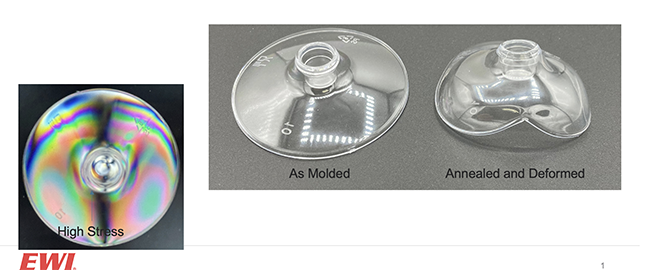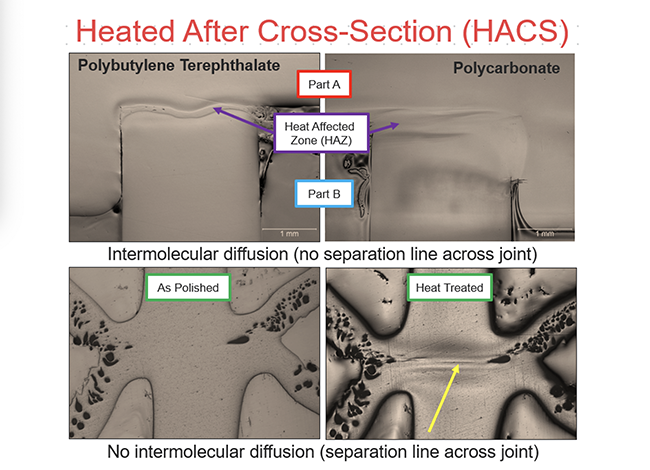Why Plastic Welds Fail 52940
You may be using the wrong joining technology for that particular plastic or creating an adhesive bond when you think you’re generating a true weld. EWI engineers describe some common plastics-joining pitfalls manufacturers encounter, and how to prevent them.
June 28, 2023

There are thousands of plastics, when you take into account the various grades and fillers, and around a dozen types of joining techniques. Matching up a polymer with the most appropriate bonding technology can be a challenge, but failing to do the homework can have serious consequences. Examples abound in the medtech and other sectors of materials peeling apart and products failing because insufficient attention was paid to the bonding process. We asked Jeff Ellis, senior technology leader, and Miranda Marcus, senior engineer, at EWI about some common pitfalls they have observed during their years at the engineering consultancy. Here’s what they told us.
Laser welding is great, but not always appropriate
Laser welding is a popular joining method among medical device manufacturers because it’s a clean process that doesn’t produce particulates and is adaptable to various geometries, said Marcus. “It’s also gentle,” added Ellis. If you have a sensor or sensitive electronics in your part, you might not want to expose it to vibrations by using ultrasonic welding, for example, said Ellis. But if you want to go the laser welding route because it has worked well in previous applications, you need to take into account the additives or lack thereof in the polymers you are joining.
“If you have two unfilled polymers, for example, heating is very difficult because the materials are so transmissive to the wavelength such that they don’t heat up. One-micron laser welding won’t work well in those applications, so we will recommend either hot tool, ultrasonic welding, or a 2-micron wavelength laser,” explained Ellis.
Weld outside your comfort zone
Companies often will select a joining process that they're familiar with for a new application. That may be the case with laser welding, as noted above, or other techniques such as ultrasonic welding. “A manufacturer may have been using ultrasonic welding for small parts and decide to continue using it to join a larger part, even though it’s not the most appropriate technology because of the part geometry or material properties or product requirements,” said Marcus. “Your material needs to have some stiffness in order to transfer the vibrations. That won’t work if you switch to an elastomeric material, for example, even if the part geometry is compatible. There are around a dozen welding technologies, and artificially limiting yourself to the one you're most familiar with can be costly in the long run,” added Marcus.
Stress tests
A problem that sometimes crops up is molded-in stress, noted Ellis. “Molders understandably want to shorten the injection molding cycle time to make as many parts as quickly as possible. But as you shorten the cycle time, the part has less time to anneal in the mold, which produces molded-in stress. When you reheat the part to do secondary joining — regardless of the joining technique you’re using — you can get deformation or cracking in the part, or it can go out of tolerance,” said Ellis. Manufacturers confronting those problems often come to EWI, which has the tools and expertise to assess the amount of molded-in stress and reduce it either through changes in the process, materials, or mold design, added Ellis.
|
If insufficient annealing time is built into the injection molding cycle, stress can result in the plastic part. |
A “hack” for testing welds
You may think you’ve achieved a weld, but are you sure you’re not just producing an adhesive bond, with all of the potential shortcomings that may entail? It can be hard to tell, according to Marcus. “It’s an issue we certainly run into — people think they are welding the parts but are, in effect, heating both materials and pressing them together. They are not achieving intermolecular diffusion,” said Marcus.
Intermolecular diffusion is when the polymer chains across the interface entangle on both sides. That's what needs to happen for a true weld to occur. “Otherwise, you just have an adhesive bond,” explained Marcus. A lot of manufacturers are using welding processes essentially to generate adhesive bonds, and it can be very difficult to tell the difference because initial testing might show it's a good, strong bond, according to Marcus. “You might have good mechanical strength, the bond might be leak-tight, but it can fail during long-term use,” she noted. If there's any thermal cycling or fatigue, environmental stresses that are getting into the assembly, that will weaken an adhesive bond much more significantly and cause failure. By contrast, an intermolecular diffusion bond can stand up to those conditions, said Marcus.
|
The Heated After Cross Section (HACS) process developed and refined by EWI ensures that intermolecular diffusion has been achieved in the joint. |
The absence of intermolecular diffusion may not be discovered during on-site testing, and EWI has developed a process called Heated After Cross Section (HACS) to remedy that. “We cross section the weld joint, grind and polish the surface, and heat treat it, allowing the polymer chains that have been mechanically pushed around during polishing to have some thermal recovery. That lets us see where the changes in the microstructure are enjoined,” explained Marcus. “You can see whether or not there's been diffusion across that weld interface.” The technique was developed and refined at EWI, and it has been the subject of some papers, said Marcus, adding that “it's gaining in popularity and hopefully more people will start using it in the industry.”
Are you really testing the weld?
Testing welded parts can be crucial — the HACS process is a good example, said Ellis — but designers don't always understand how to test their joints. “The cross-section technique described by Miranda is a destructive process, as is mechanical testing, and design engineers will cut pieces out of their parts and test them, but sometimes they're not actually testing the weld,” explained Ellis. “They may be testing the strength of the design, which has a stress concentrator, and that’s where the part is breaking instead of at the weld. They are not getting a true value of the weld strength,” said Ellis.
Device or product failure because of a mismatch in the joining technology and the materials can best be avoided by taking into account the design, materials, and processing in parallel at the start of a project. As evidenced by the examples cited by Ellis and Marcus, that doesn’t always happen. When it gets to that point, you may need a pair of fresh eyes to solve the problem, and an engineering consultancy such as EWI has the requisite tools and expertise to finish the job before, you know, things really start to fall apart.
About the Author(s)
You May Also Like






